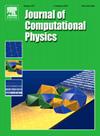A time-parallel multiple-shooting method for large-scale quantum optimal control
IF 3.8
2区 物理与天体物理
Q2 COMPUTER SCIENCE, INTERDISCIPLINARY APPLICATIONS
引用次数: 0
Abstract
Quantum optimal control plays a crucial role in quantum computing by providing the interface between compiler and hardware. Solving the optimal control problem is particularly challenging for multi-qubit gates, due to the exponential growth in computational complexity with the system's dimensionality and the deterioration of optimization convergence. To ameliorate the computational complexity of time-integration, this paper introduces a multiple-shooting approach in which the time domain is divided into multiple windows and the intermediate states at window boundaries are treated as additional optimization variables. This enables parallel computation of state evolution across time-windows, significantly accelerating objective function and gradient evaluations. Since the initial state matrix in each window is only guaranteed to be unitary upon convergence of the optimization algorithm, the conventional gate trace infidelity is replaced by a generalized infidelity that is convex for non-unitary state matrices. Continuity of the state across window boundaries is enforced by equality constraints. A quadratic penalty optimization method is used to solve the constrained optimal control problem, and an efficient adjoint technique is employed to calculate the gradients in each iteration. We demonstrate the effectiveness of the proposed method through numerical experiments on quantum Fourier transform gates in systems with 2, 3, and 4 qubits, noting a speedup of 80x for evaluating the gradient in the 4-qubit case, highlighting the method's potential for optimizing control pulses in multi-qubit quantum systems.

求助全文
约1分钟内获得全文
求助全文
来源期刊

Journal of Computational Physics
物理-计算机:跨学科应用
CiteScore
7.60
自引率
14.60%
发文量
763
审稿时长
5.8 months
期刊介绍:
Journal of Computational Physics thoroughly treats the computational aspects of physical problems, presenting techniques for the numerical solution of mathematical equations arising in all areas of physics. The journal seeks to emphasize methods that cross disciplinary boundaries.
The Journal of Computational Physics also publishes short notes of 4 pages or less (including figures, tables, and references but excluding title pages). Letters to the Editor commenting on articles already published in this Journal will also be considered. Neither notes nor letters should have an abstract.
 求助内容:
求助内容: 应助结果提醒方式:
应助结果提醒方式:


